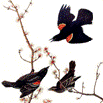Center, Internet, Wildlife Damage Management

Bird Control Seminars Proceedings
Document Type
Article
Date of this Version
November 1979
Abstract
An understanding of the feeding ecology of the red-billed quelea (Quelea quelea) is necessary for a comprehensive assessment of the potential impact of this species on cereals development. Queleas are reported to subsist primarily on wild Gramineae (Ward 1965a; Gaston 1976), but their mobility and tendency to feed in large aggregations readily adapts them to becoming a major cereal crop pest (Dyer & Ward 1977). Currently, conflicting evidence exists as to the factors involved in attacks on cereals and the relationship of depredation to the availability of wild foods. In Nigeria, Ward’s (1965a) findings indicated queleas prefer small wild grass seeds, with cultivated sorghum being extensively damaged only when the supply of grass seeds was depleted. In Ethiopia, however, Jaeger, Erickson & Jaeger (in press) have found queleas dispersing from grassland regions into areas of cereals cultivation where appreciable damage occurs to ripening sorghum at a time when wild grass seeds should be abundantly available. At present the factors affecting depredation of cereals are poorly understood. This paper examines the overall diets of Quelea quelea aethiopica (Sundevall) by sex and age in relation to depredation of the five cereals cultivated in the Awash River Basin and in terms of the types and sizes of food items eaten. Samples were collected over a one-year period from two ecologically diverse agricultural zones of the Basin, and findings are compared with those of Ward (1965a) from a considerably different ecological setting in the Lake Chad zone of Nigeria.

